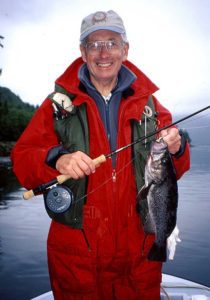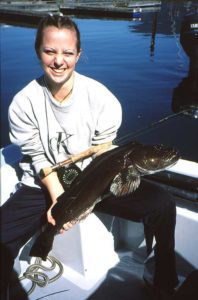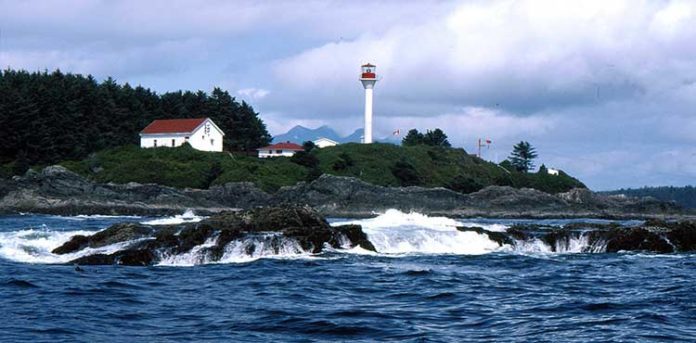Tell anyone that you plan on casting a fly to scorpionfish and they will look at you as if you are from another planet. Mention pursuing Ophiodon elongatus or Hexogrammos decagrammus with a fly rod, and they will chalk up your befuddled speech impediment to early-onset dementia. No matter, fun is in fishing, not explaining.
 Creatures of the Deep
Creatures of the Deep
For the most part, traditional fly fishers chase after various salmon and sea- run trout while out on the briny. Non- traditionalists—iconoclasts, we might call them—take delight in teasing up all those other fishes cohabiting with the salmonids. Most often those species are the various rockfishes, relatives of those scorpionfish previously mentioned, along with kelp greenling, cabezon and lingcod. Pacific halibut are actively pursued with the fly rod in California, but here around Vancouver Island they remain a rare incidental catch. Sea urchins, Dungeness crab, and sea stars do not really qualify, but are often encountered as accidental catch while plumbing the depths for some toothy critter.
Location, Location, Location
The realtor’s mantra holds true for saltwater fly fishers. Cruising around the surfline kelp beds is a good place to start. These underwater forests harbour food fishes and attract the larger predators fly fishers seek. At times, areas of open water amidst patches of kelp erupt in a near-surface feeding frenzy when rockfish bust upward through bait-balls. Mostly, the bottom dwellers prowl through the roots and rocks well below those surface waving fronds waiting to ambush some tasty morsel.
 Less obvious are the subsurface hotspots: reefs, pinnacles, humps, and other anomalies. Studying a nautical chart of the locale and carefully deciphering data will point out promising fishy locations. Chart data includes water depth and bottom composition. Nearshore areas are logical places to start, but a surprising number of good rock piles lie well out in open water. The key is to concentrate on those locations offering a water depth from about 30 to 50 ft. Beyond that depth, due largely to ocean currents, line control is adversely affected, and “honest” fly fishing is pretty much a myth.
Less obvious are the subsurface hotspots: reefs, pinnacles, humps, and other anomalies. Studying a nautical chart of the locale and carefully deciphering data will point out promising fishy locations. Chart data includes water depth and bottom composition. Nearshore areas are logical places to start, but a surprising number of good rock piles lie well out in open water. The key is to concentrate on those locations offering a water depth from about 30 to 50 ft. Beyond that depth, due largely to ocean currents, line control is adversely affected, and “honest” fly fishing is pretty much a myth.
Tidal Influence
Current speed and direction often dictates which side of the anomaly holds fish. Downstream eddies swirl bait fish into tight packs which offer our quarry opportunity for a snack. Again, nautical charts show current direction and speed. Some places fish best on a rising tide, while others are ebb tide hotspots. Only experience will give you that information. Obviously, low tide means there is less water between you and the rock pile. Although that makes it easier to probe the bottom with your fly, low slack tide tends to disperse the fish.
Tackle and Technique
 A seaworthy boat and reliable engine and a combination GPS/depth sounder to get you over the top of a pinnacle are the main large-ticket items. The basic kit includes fly rods in the eight-weight and up category, with backbone enough to lever up a stubborn fish trying to wedge itself in the bottom rubble, and corrosion-resistant fly reels holding fly line and lots of backing.
A seaworthy boat and reliable engine and a combination GPS/depth sounder to get you over the top of a pinnacle are the main large-ticket items. The basic kit includes fly rods in the eight-weight and up category, with backbone enough to lever up a stubborn fish trying to wedge itself in the bottom rubble, and corrosion-resistant fly reels holding fly line and lots of backing.
Fly lines range from heavy 400-500 grain sink tips, to full-sinking tungsten impregnated deep divers to shooting heads comprised of various lengths of lead-core (LC13) trolling line. A second rod rigged with a floating line comes in handy on those occasions when you can cover an eruption of rockfish with a surface popper. Try monofilament leaders, four or five feet long, starting at 10-lb test; beware, heavier leaders may prove problematic when trying to bust off a fly wedged in a rock crevice.
Casting these heavyweights is a matter of slowing your rhythm, opening your loops, following through, and practice. Simply lay out the line as best you can to straighten the leader, then hand feed line as it plunges to the bottom. We are concerned with vertical, not lateral, distance. When you can no longer stand the suspense, and a fish has not grabbed your fly on the way down, start a jerky line retrieve with pauses and drop-backs. Keep doing that until you can clearly see your fly. Often an interested fish will follow nearly to the surface. Paying attention may give you the opportunity to quickly drop your rod tip and offer one last chance for a hookup. Then again, you might pick up a “hitch-hiker”—a larger fish that gloms onto the smaller fish you have hooked. Most often the freeloader lets go near the surface, but it can be fun while it lasts.
Fly Patterns
Bottom dwellers will attack just about anything. Give them a fly meaty enough to attract their attention, one with a lot of mobility and flash, heavy enough to drop quickly into their feeding zone. Durable materials make for better longevity and less downtime changing flies. Stout wire hooks reduce deformation and fish loss while prying up a big one from its holt. Many patterns originally developed for northern pike and musky come to mind. This is the time to let your creativity run amok. ![]()






